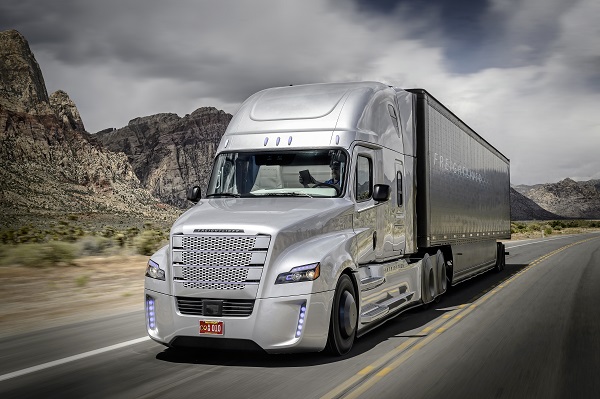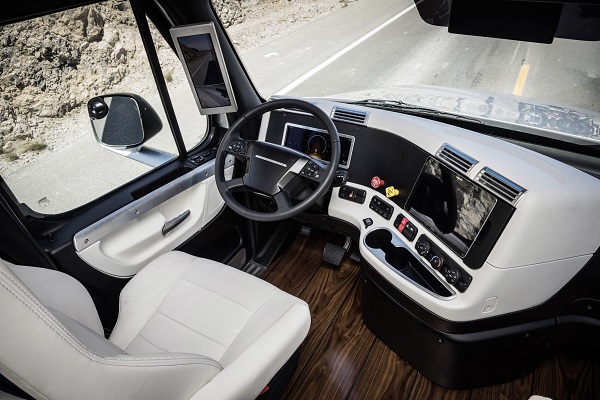The introduction of driverless vehicles may be nothing more than science fiction in some people’s minds, but the reality is technology giants across the globe, such as Google, are investing heavily in developing the concept which shows it is closer to reality than people think. By Richard Newbold.

Daimler, one of the world’s largest manufacturers of trucks, recently demonstrated a prototype truck which drove autonomously on an autobahn in Germany. This truck successfully navigated a junction in real driving conditions. This demonstration showed us just how real the technology is. Daimler’s demonstrated the truck as part of its ‘Future Truck 2025’ strategy. Trucks will be equipped with their ‘Highway Pilot’ assistance system which allows them to navigate successfully at speeds up to 85kph.
The introduction of driverless trucks could be the biggest change the road haulage industry will ever see. With that in mind we look at the driving force behind driverless trucks.
Costs
Throughout Europe it is estimated that around 45% of the total cost for road haulage operators is attributed to the driver. By eventually removing the driver it would obviously then have a huge impact on road haulage costs, margins and profits. There is no indication that this technology will ‘replace’ existing drivers in the future, the technology will be there as an aid to the driver and help free up time for them to work on other duties to maximize their time.
Driver shortage
 Another reason behind introducing driverless trucks is the driver shortage crisis. People seem more unwilling to commit to a career as a HGV driver due to many reasons including the long hours away from home, the relatively low pay, the poor image of the industry and the working conditions. This will soon translate in to higher costs for haulage operators and their clients. By removing most of the stress from driving by leaving the important decisions to a computer, the working conditions should become much more attractive. There could also be the opportunity for the driver role to change into a more enhanced role by adding transport management duties that could be completed during the time periods the computer is in control.
Another reason behind introducing driverless trucks is the driver shortage crisis. People seem more unwilling to commit to a career as a HGV driver due to many reasons including the long hours away from home, the relatively low pay, the poor image of the industry and the working conditions. This will soon translate in to higher costs for haulage operators and their clients. By removing most of the stress from driving by leaving the important decisions to a computer, the working conditions should become much more attractive. There could also be the opportunity for the driver role to change into a more enhanced role by adding transport management duties that could be completed during the time periods the computer is in control.
Safety
Public perception will demand absolute reliability with this new technology. It will need to be proven before any driverless vehicle is allowed on the motorways. Any operation involving driverless vehicles on public roads will need to be part of a much larger system, a system that perhaps is not quite a reality as of yet.
Congestion
One of the leading reasons for the heavy investment in to this technology is the potential increase in transport efficiency. With road congestion predicted to continue to rise in the near future, there is a real need to break the link between economic growth and road transport. German authorities have predicted that truck transport volume will increase by 39% by 2030 unless something is done to stop it. The construction of new roads is very unpopular with environmentalists and many countries in Europe just do not have the funds available to pay for that kind of extra road infrastructure. Major road networks in Europe have hardly grown in the last ten years and that’s why it becomes essential to use existing road capacity more efficiently and driverless vehicles can help achieving in this goal.
The Technology
There have been major developments with technology in terms of assisting the driver. Daimler’s ‘Proximity Control Assist’ will adapt the speed of the vehicle depending on the traffic situation through an integral cruise control and braking system. Three-dimensional maps already exist for a ‘Predictive Powertrain Control’ system and telematics products for vehicle and transport management for the driver and operator have already been rolled out.
Vehicle manufacturers believe that the driver will still be essential to the driving process in the next ten years. The technology will be there to assist the driver rather than take their job.
Richard Newbold is the founder of returnloads.net and www.aaa-transport.co.uk/ and has spent thirty years in the transport and logistics industry. Returnloads.net is an online freight exchange that helps companies find return loads for their return journeys. The site has around 90,000 loads added every month and close to 2,000 members. Subscriptions start from £29.95/month.
Photos: Daimler driveless truck and the cab interior.
Click here for the next Editor's Pick